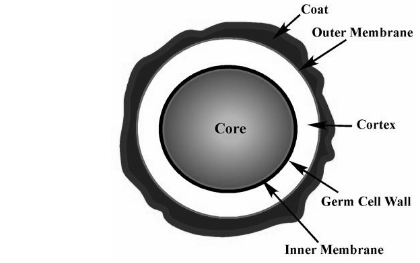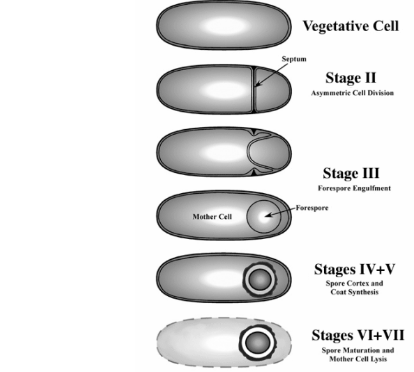In microbiology, an endospore is a dormant, tough, and non-reproductive structure produced by certain bacteria of the Firmicute phylum that is not capable of reproducing. Lack of nutrients is usually the catalyst for endospore formation, which occurs most frequently in Gram-positive bacteria. The bacterium divides within its own cell wall during the process of endospore formation. Then one side completely engulfs the other. Endospores allow bacteria to remain dormant for long periods of time, sometimes even centuries. When the environment becomes more favourable, the endospore has the ability to reactivate and return to the vegetative state. Bacillus and Clostridium are examples of bacteria that can produce endospores in their cells.
The endospore is made up of the bacterium’s DNA as well as a portion of its cytoplasm, and it is protected from the environment by a very tough outer coating. Endospores are capable of surviving in the absence of nutrients. Extreme temperatures, desiccation, ultraviolet radiation as well as chemical disinfectants are not a problem for these plants. The majority of the time, they can be found in soil or water, where they can survive for extended periods of time. Bacteria produce a single endospore on the inside of their cells.

Endospore Structure
The peculiar cellular structure of an endospore can be attributed in part to its high resistance to damage. The outer proteinaceous coat that surrounds the spore is responsible for a large portion of the spore’s chemical and enzymatic resistance. The cortex is a very thick layer of specific peptidoglycan that lies beneath the coat of a mammalian animal.
Dehydration of the spore core is required for proper cortex formation, which aids in the spore core’s resistance to high temperatures. A germ cell wall can be found beneath the cortex. After the endospore germinates, this layer of peptidoglycan will transform into the cell wall of the bacterial organism. The inner membrane, which lies beneath the germ cell wall, serves as a significant permeability barrier against a variety of potentially harmful chemicals. When the endospore is in its core stage, it is extremely dry, and it contains the DNA of the cell as well as ribosomes and vast amounts of dipicolinic acid.
This endospore-specific chemical can account for up to 10% of the dry weight of a spore and appears to be important in the maintenance of spore dormancy, according to the research. Small acid-soluble proteins (SASPs) are also only found in endospores, and they are essential for their survival. These proteins bind and condense DNA in a very tight manner, and they are partially responsible for the DNA’s resilience to UV light and DNA-damaging substances. In addition to endospores, other species-specific structures and substances are linked with them, such as stalks, toxin crystals, or an extra exterior glycoprotein coating known as the exosporium.

Endospores Development
The formation of an endospore is a complicated process. Bacillus subtilis is the model organism that has been used to study endospore development. Endospore formation is a lengthy process that takes several hours to finish. In order to distinguish between phases of development, key morphological alterations have been identified throughout the process.
When a cell begins the process of generating an endospore, it splits in an asymmetrical pattern (Stage II). In turn, this leads to the formation of two compartments: the larger mother cell and the more compact forespore (see illustration). The developmental destinies of these two cells are diametrically opposed. Specifically, intercellular communication systems coordinate cell-specific gene expression by the sequential activation of specialised sigma factors in each of the cells in the intercellular communication system.
The peptidoglycan in the septum is then destroyed, and the forespore is engulfed by the mother cell, resulting in the formation of a cell within a cell (Stage III). After the forespore has been formed, the mother cell’s actions result in the synthesis of endospore-specific chemicals (Stages IV+V), as well as the creation of the cortex and the deposition of the coat. Finally, the endospore is dehydrated and matured (Stages VI+VII), which is the ultimate stage of development.
The mother cell is then killed by the process of programmed cell death, and the endospore is discharged into the surrounding environment. After a period of dormancy, the endospore will awaken when it perceives the return of more favourable conditions. In order for gene expression to begin, the RNA polymerase must be directed to certain sites on the DNA. [A sigma factor is a tiny protein that does this.]

Conclusion
Bacterial endospores are all exceedingly inactive, and they all have strong, but very diverse, resistances to heat, other physical and chemical agents, enzymes, and other environmental factors. The heat resistance of the equivalent vegetative cell is typically up to 105 times larger than that of the corresponding animal cell. Spores increase the intrinsic resistance of their contents by 40°C to 55°C by adding additional resistance to their contents. The processes of spore dormancy and resistance are multicomponent in nature. A low water content in the core protoplast, high amounts of calcium dipicolinate in the protoplast, immobilisation of small molecules, and protection of DNA by small acid-soluble proteins, whose binding to DNA is increased by dehydration, are some of the characteristics. Spores’ peculiar compartmentalization during sporulation, which results in a core protoplast surrounded by the peptidoglycan cortex and coats, is a critical step in the development of their dormancy and resistance mechanisms, among other things. The coats of spores are not required for the maintenance of resistance and dormancy; nevertheless, the cortex is required for these functions. It somehow manages to keep the protoplast that it encloses at a low water level, albeit the exact mechanism by which it does so is unknown.
Although some types of spores can be engineered to germinate quickly and lose their resistance properties, the deliberate use of germination as a spore control procedure in foods has not been successful due to the reluctance of populations of naturally occurring spores to germinate quickly and completely in the absence of an external stimulus. It is possible that new preservation techniques will ultimately provide an alternative to spore control operations. Examples include the germination of spores under high hydrostatic pressures (but not sufficiently to serve as the basis of novel sterilisation techniques at the time of writing).
 Profile
Profile Settings
Settings Refer your friends
Refer your friends Sign out
Sign out




